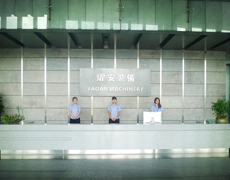Your Location : Home > News > Details The 8 important principles of plastic extrusion
1 Mechanical Principles
The basic mechanism of extrusion is very simple -- a screw in the cylinder to rotate and the plastic forward. Screw is actually a slant or slope, winding on the core layer. Its purpose is to increase the pressure in order to overcome the larger resistance. A extrusion machine, there are 3 kinds of resistance to be overcome: solid particles (feed) on the cylinder wall friction and the screw rotation laps when (feed) mutual friction between them; the melt in the barrel wall adhesion; melt pushed forward logistics resistance inside.
Newton once said, if an object is not to a given direction, then the body force is in this direction balance. Not to screw axial movement, although it may be in the circumferential near horizontal fast rotation. Therefore, the axial force is balanced by the screw, and if it is applied to the plastic melt a large forward thrust it also give an object applied the same backward thrust. Here, it applied thrust bearings in the feed back -- thrust bearing.
The majority of single screw is right hand thread, like woodwork and machine screw and bolt. If viewed from behind, they are reverse rotation, because they will try to spin out the barrel backwards. In a double screw extruder, two screw in the two cylinder rotates in the reverse direction and cross each other, so one must be to the right side, another must be left to the. In other occlusal twin screw, two screw with the same direction of rotation which must have the same orientation. However, no matter what kind of situation has absorbed the thrust bearing backward force, Newton's principle is still applicable.
The 2 heat principle
Extrudable thermoplastic plastics -- they when heated and melted and solidified again during cooling. Melt the plastic heat come from? Feed preheating and cylinder / die heater may play a role in the initiation and very important, however, the motor input energy -- motor overcomes viscous melt resistance generated when the rotation of the screw rod in the cylinder friction heat -- is the most important source of all plastics, except for small system, low speed, high melt temperature and screw plastics extrusion coating application.
For all other operations, recognizing the main source of heat tube heater is not in operation is very important, so the extrusion effect than we expected may be small (see rule eleventh). After the barrel temperature may still important, because it affects the tooth or into the solid material conveying speed in the. Die and mould temperature should typically be melt temperature want or close to this temperature for a specific purpose, unless they like polishing, fluid distribution or pressure control.
The 3 reduction principle
In the majority of the extruder screw speed, change is achieved by adjusting the motor speed. Motor is usually rotating at full speed of about 1750rpm, but that of an extruder screw was too fast. If the rotation so quickly, generates too much friction heat and residence time of plastic is too short to the preparation of uniform, good stirring of the melt. The typical speed reduction ratio between 10:1 to 20:1. The first stage can be used gear can also block, but the second stage gear and screw positioning at the end of a big gear center.
In some slow running machine (double screw such as a UPVC), there may be 3 deceleration phases and the maximum speed may be low to 30rpm or less (ratio 60:1). At the other extreme, some for stirring speed twin-screw long can be 600rpm or faster, and therefore require a very low rate of deceleration and many deep cooling.
Sometimes the rate of deceleration and task matching error -- there will be too much energy can not be used -- and may increase a pulley block between the first deceleration motor and change the maximum speed. This can make the screw speed increased to more than the previous limit or reduce the percentage of maximum speed allows the system to run at maximum speed greater. This will increase the available energy, reduce and avoid the motor amperage. In the two case, according to the material and the cooling needs, the output may increase.
The 4 feeding as coolant
Extrusion is the electrical energy -- sometimes heater -- transferred to the cold plastic, then put it into the melt from the solid. The input feed ratio feeding area in the barrel and screw surface temperature low. However, to the surface of the cylinder body material area is almost always on the plastic melting range. It is cooled by and feed grain contact, but the heat from the heat transfer of heat as well as the front end to the back end can control the heating and maintain. Even the end of heat by viscous friction and does not need to keep the cylinder heat input, may need to open the heater. The most important exception is the groove into the barrel, almost exclusively for HDPE.
Screw root surface is also feed cooling and plastic (feed particles and between the particles from the air) adiabatic wall. If the screw suddenly stopped, feed also stopped, and because heat move backward from the front end more heat, the surface of the screw become more heat in the feed zone. This may be caused by particles in the roots of the adhesion or bypass.
5 screw at the end of the pressure is very important
The pressure screw all the objects reflect the downstream resistance: the filter and pollution breaker plate, adapter pipe, fixed stirrer (if any) and the die. It not only depends on the geometry of these components is also dependent on the system temperature, which in turn affect the viscosity of the resin and the speed. It does not depend on the screw design, except it effects of temperature, viscosity and by volume. For safety reasons, temperature measurement is very important -- if it is too high, the die and mold may explode and damage to nearby personnel or machine.
Pressure is favorable to the mixing, especially in the area of single screw system (metering zone). However, the high pressure also means that the motor to increase energy output -- and therefore a higher melt temperature -- this can be specified pressure limit. In the twin screw, two screw mutual occlusion is a more effective stirrer, so no pressure is needed for this purpose.
In the manufacture of hollow parts, such as the use of stents to spider die core positioning of manufacturing tube, must be produced in very high pressure in the mold to help separate logistics re combination. Otherwise, along the weld line of products may be weak and problems that may occur when in use.
The displacement / pressure logistics 6 output = the last thread and leakage
Displacement last thread is called the flow, only depend on the geometry of the screw, screw speed and melt density. It consists of pressure flow regulating, actually includes the reduction of output resistance effect (represented by the highest pressure) and add any feed output in the occlusion effect. Leakage threads may be any of two directions in one direction.
Calculated for each RPM (turn) output is useful, because it represents a time of the screw pump out the capabilities of any decline. Another related calculation is used in output per horsepower or kilowatt. This representation and to estimate the efficiency of a given motor and drive production capacity.
7 shear rate plays a major role in viscosity
All the ordinary plastics have shear fall characteristics, means more and more quickly when the viscosity is low in the plastic motion. The effect of some plastic that was especially evident. For example, some of the PVCs in the thrust double flow will increase 10 times or more. In contrast, LLDPE shear drop is not too much, reasoning doubled when its velocity increased by only 3 to 4 times. To reduce the shear reduction effect means that the high viscosity under the extrusion conditions, which in turn means more motor power. This may explain why the LLDPE operation when the temperature is higher than LDPE. Flow with shear rate, is about 100s-1 in the screw channel, in the majority of mold in the mouth is between 100 and 100s-1, with the cylinder wall thread clearance and some small die gap is larger than 100s-1. Melt coefficient is a commonly used method for measuring viscosity but upside down (such as flow / thrust rather than thrust / volume). Unfortunately, it is measured in the shear rate in 10s-1 or more hours and in extrusion may not be a true measurement machine melt flow quickly.
8 motor and cylinder opposition, cylinder and motor opposition
Why not control cylinder is expected, especially in the measurement area? If the heating cylinder, cylinder wall material layer viscosity becomes smaller, the motor in need this more smooth barrel run less energy. The motor current (Amperes) decreased. On the contrary, if the cooling cylinder, cylinder wall of the melt viscosity is increased, the motor must be harder to turn, amperage increase, through the barrel body of some heat removed by the motor back to. Usually, the barrel adjuster does have effect on the melt, which is what we expect, but any local effects are no regional variables. The best is the measurement of melt temperature to really know what happened.
The eighth principle is not applicable to die and die, because there is no screw rotation. This is why the external temperature changes where more effective. However, these changes are from the inside to the outside and not uniform, except at a fixed stirrer mix, which is an effective tool for the melt temperature and stirring.







